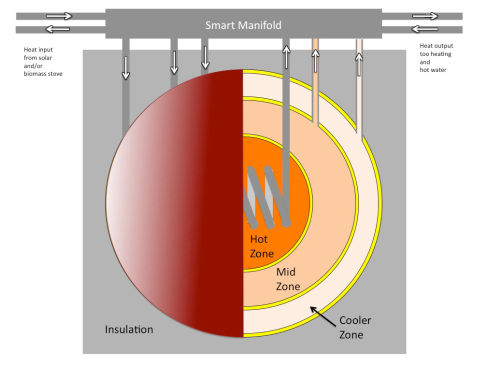Secure Supplies Group

Heat Thermal Battery Storage
We have further developed the worlds most efficient thermal storage device.
It can hold very high temperatures in small spaces for long periods of time.
We can, we call it the Hot Box.
The CHP Orc Turbine By Secure Supplies and the Injected Liquid Heat Fischer engine runs on Pressure Expansion. No fuel is necessary to power it, but you do need a heat source.
The Hot Box act as a capacitor for Secure Supplies Heat and absorbs heat through electric
Cal-rods or by circulating a heat transfer liquid.
The Fischer Generator takes energy out of the air for free at a persons home , Business or Vehicle.
Secure Supplies Low Pressure Heat Pump Systems can charge the Hot Box in their location with their Fischer Generator at night while they are sleeping.
A special Hot Box model was made for cars as well as other heat storage models. Through special state of the art insulation, the very high temperature heat could remain in the Hot Box all day (or even all week long).
By the way, there is another type of engine cycle that BWT makes that can run your engines or turbine run an electric generator without exhaust or the need for a condenser.
It is called the ORC Turbine or another is Sterling Engine Cycle.
It runs just on heat. All you need is a heat source. Secure Supplies has Master the art of pressure with out heat.
With the Hot Box, your vehicles or power plants could also be powered with this engine type.
What is a thermal battery?
Thermal mass of any kind can by definition be called a thermal battery, as it has the ability to store heat. In the context of a house, that means dense materials like bricks, masonry and concrete.
Even a jug of water sitting in a sunny window is a thermal battery of sorts as it captures and later releases heat from the sun.
A well-insulated concrete floor acts as a thermal battery as well; once you pump it full of heat it takes a long time to cool down (depending on the thickness), and it regulates interior temperatures during that time.
One practical use for getting the most from a radiant concrete floor as a thermal battery would be in areas with fluctuating energy costs - you can set your floor on a timer so it only comes on during low-rate hours (7pm to 7am in Ontario for example).
During the twelve hours that it is off, it acts as a battery by slowly releasing the stored heat, so you avoid having to pay the higher rates during peak-hours.

As you move into the area of active heat-storage systems, one of the more common types of thermal battery (not that there are a lot of them) is a huge water tank buried in the ground that is heated by solar thermal panels.
Even this type of system is not new, the first house in the United States with an active solar heating system was built In 1939 on the MIT campus (Massachusetts Institute of Technology), and sat on top of a huge water reservoir that was heated by thermal solar panels.

What are phase change thermal batteries?
Taking advantage of a 'phase change' raises the bar a bit - stick with me, it will be fun, I promise :)
A significant input of energy is required to cause a material to change from a solid to liquid. That energy is later released when that material solidifies again.
While those transformations are happening and the material is either absorbing or releasing energy, the temperature will stay constant. Once the phase change is complete, the material will begin to change temperature again.
So what does that mean in real terms? It means that in order to melt water, wax, metal, rock or whatever, you need to feed it a ton of energy. but the temperature doesn’t change while you are doing that. So your ‘battery’ has more power, and you can store more heat in the same volume of space.
It’s difficult to take advantage of a melting point of 0° Celsius, but wax melts at about 37° Celsius (depending on its exact chemical makeup), which is perfect for collecting and storing heat from solar thermal collectors.

How to build a thermal battery:
If you had a heat-collecting solar panel (directly heating air or liquid rather than generating power with photovoltaics), you can use that to charge your thermal battery. Envision this - a large tank of wax (or water) that is warmed by heated coils from a solar collector. Through that same tank runs another coil that is extracting the heat to pump it through your radiant floor or whatever other heating distribution system you have.
Specific Heat Capacity:
If you take solid paraffin (heat capacity Cp = 2.5 kJ/kg·K and heat of fusion of 210 kJ/kg), let's say 1 kg, at room temperature, you will need 2.5 kJ (kilojoules) of heat to make the 1 kg block go from 20°C to 21°C. To make it go from 21°C to 22°C, you will also need 2.5 kJ (i.e. the same amount of energy).
Paraffin melts at approximately 37°C. If it drops to 36°C, you will again only need 2.5 kJ to bring it back to 37°C, but you would need 210 kJ (84 times as much) to go from 37 to 38°C.
This is because in order to melt, some chemical bonds in the solid lattice need to be broken, a process that requires extra energy. So overall, if a kg of paraffin is lying around at 20°C, you would need 252.5 kJ to bring it to 38°C.
One of the more common building materials with thermal mass benefits is concrete. In contrast to paraffin, 1 kg of concrete (Cp = 0.88 kJ/kg·K) would need 15.8 kJ to do the same. For water (Cp = 4.18 kJ/kg·K), the amount of energy required would be 75.2 kJ.
The amount of energy put in is the amount of energy stored in a material, as this energy will later be released as the material cools back down to 20°C, or room temperature. While there are many materials that can be used in the application of heat storage, this is just a quick comparison of some of the more commonly available ones.
So to conclude, paraffin can store 16 times as much heat per kg as concrete, and 3.4 times as much as water. So while water may not be the best material to store heat, it certainly is the most affordably priced and easily accessible.
The Cp value referred to in the above text refers to the heat capacity of materials.
q = m Cp ΔT
where:
q = energy [J]
m = mass of material [kg]
Cp = heat capacity of the material [kJ/(kg·K)]
ΔT = temperature difference [K or °C]

Hot Box Demo
This was one of the first demo models of the Hot Box. It uses sand (which has a very high specific heat) and a metal matrix to transfer the heat in and out. We could hold 33,000 BTU's storage per cubic foot...then a record!







Zeolite thermal storage retains heat indefinitely, absorbs four times more heat than water Secure Supplies Adds 1 Special Chemical to Unlock HIGH BTU with Long Electrictro Thermal Run Times.

Secure Supplies
The Water to Heat Battery and Steam and Power Box is Ready for Ordering.
-
Water to Gas
-
Gas to Heat No Flame
-
Heat to Heat Battery
-
Heat to Power
-
Heat to Steam for De Icing Work
-
10 x 5 x 4 Foot Fork Lift Skid
-
Water Proof Rust Proof
-
24 Hr Run Times.
-
WhatsApp + 1 520 848 1659


Zeolite pellets that can store up to four times more heat than water, loss-free for “lengthy periods of time.” In theory, you can store heat in these pellets, and then extract exactly the same amount of heat after an indeterminate amount of time.
Zeolites (literally “boil stones”) aren’t exactly new: The term was coined in 1756 by Axel Cronstedt, a Swedish mineralogist who noted that some minerals, upon being heated, release large amounts of steam from water that had been previously adsorbed. For the last 250 years, scientists have tried to shoehorn this process in a heat storage system — and now, the Fraunhofer Institute, working with industrial partners, has worked out how to do it.
I will try to explain how this works, but the science is fairly complicated: When Fraunhofer’s zeolite comes into contact with water, a chemical reaction adsorbs the water and emits heat. When heat is applied to the zeolite, the process is reversed and the water is released. Because the heat is locked up in the chemical structure of the zeolite, the material never actually feels warm — which is why this is a “loss-free” storage method.
These two processes can be kept separate — so first you charge the balls up with heat, and then later you can just add water (!) to release the heat. This reaction occurs all along the surface of the zeolite — and because zeolites are porous, a single gram of the material has a surface area of 1000 square meters (10,700sqft). It is for this reason that Fraunhofer’s zeolite can store up to four times more heat than water.
Large Commercial Hot Box
We had to build a unit that was pretty large and very cumbersome to store just over 2 million BTU's of heat. There was enough stored energy in one unit to make 2-3,000 gallons of hot water or heat a large building.
Improved Commercial Hot Box Model
We discovered a material that was 9 times the specific heat of sand. So, we could store 300,000 BTU's in one cu. ft. So, we could build the unit much smaller and wiser. This Hot Box is only 3' x 3' x 3' = 9 cu. ft. for 2 MBTU's+.-
Improved Commercial Hot Box Diagram
To get the heat out of the Hot Box, there is a thermostat in a closed mixing chamber that regulates the transfer of heat to keep the pressures in line. Air is less volatile than liquids to take the heat from the Hot Box below.
INsulated with Secure Supplies Special High Pressure Design At 1200 degrees C (over 2,000 degrees F)

Gas to Heat Battery Catalytic







Steam Engine

Steam Engine

Steam Engine

Steam Engine




Turbo Heat Fan runs off the heat of your woodstove.
The secret of the Free Heat fan is a small stirling engine housed in the square base of the unit.
Stirling engines have been around for decades but no one has ever come up with a marketable way to use them.
They consist of a sealed chamber that expands quickly when heated and contracts when it cools down.
The heating up and cooling down happens almost instantly.
The piston in the small engine drives an offset crank that drives the fan.
The unit weighs about 15 lbs. and has a 14" diameter, 8-bladed fan. You just set the unit freely on top of a hot surface. Needs no batteries, fuel or electricity.
BASE PRICE
$289.00



